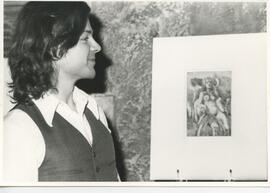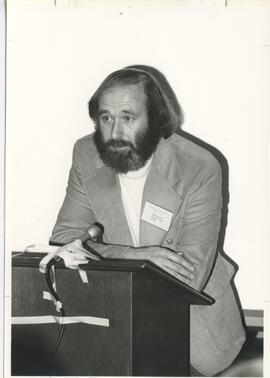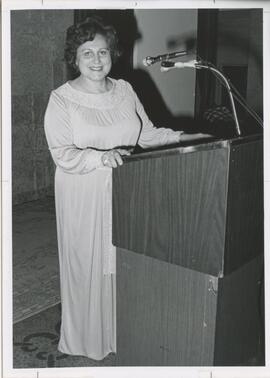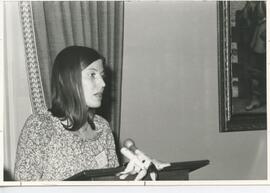This item is a recording about artist William Kurelek and author Myrna Kostash
This item contains recordings from the Second Banff Conference on Central and East European Studies.
Presentation by Mr. Petr Czarnowsky: Eastern Europeans, despite their proportion of the population, came to form a large number, often over 50% of ethnic associations in Alberta. This includes ethnic organizations, arts organizations, and linguistic schools. Policies of multiculturalism have helped to form these figures, but have had the unforeseen consequence of adding to confusion about Eastern European ethnic groups on the part of students and teachers alike.
Presentation by Mr. Joanna Mateko on the problems already being faced in the study of Poles. She came from Poland associated with the Polish Academy of Sciences in Warsaw for 15 years. She did work in the field of Polish history, having published numerous articles and co-author of bibliographies that were compiled by the Polish academy of sciences. She does her research on the Poles in Alberta. A problem that exists in the study of Poles is the inaccuracy of academic and official documents pertaining to Polish settlement in Canada, and the difficulty in unearthing accurate depictions and statistics of Polish settlers, and Slavic settlers more generally. This can be derived from a lack of knowledge from Canadian officials, and a lack of consciousness amongst many Slavic groups, particularly the Poles and Ukrainians.
Presentation by Mr. John Sokolowski, a graduate student in the department of Slavic Languages, his first graduate program was as a Classicist. He does work on the Russians and Belarussians. He started his work on the East Slavs, the Russians, Belarussians, and Ukrainians in Alberta. They no longer work on the Ukrainians as so much work has been published. They started their study with the Russians and Belarussians, they hope to determine an accurate number of people of Russian and Belarussian origin in Alberta. Contention on the accurate number of Russians and Belarussians in Canada, as the definition of Russian has changed over time, with many early documents associating many non-Russian ethnic groups as Russian. Dynamics have changed with census records over the years, which still continue to be unreliable. There is thought to be far more Belarussians in Canada than official census documents would suggest.
Presentation by Mrs. Dr. Yermilla Horna University of Calgary Department of Sociology. Dr. Horna was educated in Prague and Bratislava came to Canada in ’58, taking part in the project doing the history of the Czechs and the Slovaks. She got a grant for the study of patterns of adjustment of Czechoslovaks, the so called refugees of 1968-1969. The study focused on pre-1968 settlement of Czechoslovaks in Canada to figure out if incoming refugees had a previous basis to go off of, or had to ‘start from scratch’. Research found majority of Czechoslovaks came to Alberta as miners, farmers, or other labourers, mostly from Slovakia. Greatest wave of Czechoslovak migration prior to 1968 came in 1885.
Presentation by Mr. Kostash: Talks about the function of universities. Talks about how East European and Soviet Studies at the university follows the same functions. Mentions that one who takes particular focus on the East European courses offered by the University can find themselves being skilled and knowledgeable scholars. Initiatives by professors at the university to make sure students in the field go out to the ethnic communities to get a feel for how they are. Talks about the importance of community approval and funding for new programs. Stresses transparency of activities in programs as it relates to the community.
Presentation by Mr. Duruviches, a member of the Lithuanian community, and President of the Baltic Society: Discusses the contention with the label ‘Soviet’, coming from Lithuania, and the history Lithuania has with the Soviet Union. The importance of having a place such as a University to study one’s heritage. Expects from the University that it is kept in mind that although their issues are similar at the moment, that Baltic peoples are not Slavic peoples.
Presentation by Dr. Bergin from the Faculty of Education: has a strong interest in Mennonite culture. Difficulties because of mixed loyalties on representing different groups; particularly the Mennonites, who aren’t easily identified by typical visages.
Presentation by Dr. Sukoversky: the definition of a collection, and that professors start collections. Students can start collections too. Ethnic groups can start collections.
Presentation by the Chairman of Edmonton Historical Board
Presentation by Mr. Kistner: Wasn’t prepared to present but is talking from the perspective of a foot soldier. He is Baltic German born in Tallinn Estonia. Talks about how maps often forget about the islands of Estonia. Baltic Germans is a very small group. It’s worthwhile for even very small groups to write their history and preserve their heritage. In doing work there’s lots of assistance needed, time, and footwork. Being a small group has its advantages, no need for sampling.
This item contains a recording of a CEESSA Meeting held on September 14, 1976. Topics covered include:
A meeting regarding the project
The government of Alberta gave money for the project
Aim of part 1 of the project on East European groups – to write a book about historical background of East European immigration; size and distribution of their settlements. The book will be comprised of 10 chapters.
Mrs. Matejko on progress of the work: the work started on October of last year with statistics of all kinds on Central and Eastern European groups. Search in the Provincial Archives. Compiled bibliographies. The most detailed ones are on Poles, Russian Germans, and Jews. Less information on Romanians or people from the Baltic countries.
A need to find private collections of documents and cover 3 waves of immigration. Problems: some communities came in the 1880s, very early, like Russian Germans. Latvian immigrants were very rare, mostly after WWII.
Volunteers are needed to make contacts with old timers and do fieldwork. Germans are the largest community in Alberta coming from Volga region, Black Sea region, and Volyn apart from those from Reich. Mr. Sokolovsky was a research assistant last year and did a great job on Russians, Byelorussians. 2/3 Germans in Alberta are from Central and Eastern Europe.
Problems with counting Czechs and Slovaks because of the former Czechoslovakia. Dr. Horna is working on Slovaks group. Ms. Birzgalis is writing a massive thesis on Latvian community in Alberta (around 1010 people altogether). And Latvian community is very young and predominantly urban comparing to other ethnic groups.
Romanian community research – there is an old settler who was born in Romania. A student in anthropology in Calgary wrote thesis on Polish community – there is interest from outside and people want to help..
A linguist from Poland studies the changes of Polish language in Alberta. He has many interviews with life stories.
High schools now offer a course on ethnic groups in Alberta – they could use a source book from CEESSA.
Discussing that 5 ethnic groups under consideration now but possibly extending the number of ethnic groups for research.
Problems of intermixed settlements of Romanians.
Grant of $10000 for research: $5000 for research associates, $4000 – for field trips, $1000 – for typing.
Mrs. Matejco will be working on all the ethnic communities in addition to the Polish one, and she will get half of that grant money. The University is going to handle the money so that CEESSA will not have to deal with the receipts and report to the Ministry.
Mrs. Matejko used to work on the project for free but put in a lot of time and effort.
Field trips should be longer and more extensive when there is money.
Mrs. Horna will be paid only for her trips and Xeroxing.
People interested in working on 2 different ethnic communities on their own budget (one is a former student working in the Provincial Archives).
To complete the project, trips to the National Archives in Ottawa and archives in Toronto should be made + a trip to the B.C. Archives and Saskatoon – those have unique sources that must be included.
Dr. Rudnytskyi and Dr. [Lupul] were assigned to do a federal project on history of Ukrainians in Canada. The project is far from being completed. CEESSA did not touch the Ukrainian community because they already have the Ukrainian Institute working on it and various funding.
The German community is more difficult than any other one – they are spread all over the province.
Federal government project includes 20 ethnic groups. The only group that was not approached was Slovenes. Dr. Priestley was then asked to do the work on that group. Another group was Finns – someone is researching them now.
The federal government is not going to give money any more for researching ethnic communities because it already did so. But money could be obtained for compiling and publishing memoirs of the pioneers – it could become a bestseller.
Getting money from Canada Council would enable to finish the project without begging from the communities.




